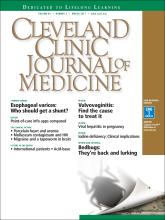Article Figures & Data
Tables
Age group Clinical manifestations Fetus Abortion
Stillbirth
Increased risk of perinatal death
CretinismInfant Goiter
Hypothyroidism
Mental retardation
Intellectual impairmentChild, adolescent Goiter
Hypothyroidism
Intellectual impairment
Impaired physical developmentAdult Goiter
Toxic multinodular goiter
Increased risk of iodine-induced hyperthyroidism
Hypothyroidism
Intellectual impairmentAdapted from reference 9.
Neurologic cretinisma Myxomatous cretinisma Period of intrauterine iodine deficiency Early in pregnancy (maternal hypothyroidism) Late in pregnancy Continuing postnatal iodine deficiency No Yes Deaf-mutism Often present Absent Neurologic deficits
Gait disturbances
Spasticity
SquintingOften present Absent Growth Normal Growth retardation
Epiphyseal dysgenesisPhysical signs of hypothyroidism
Coarse, dry skin
Hoarseness
Delayed relaxation of reflexesAbsent Present Effect of thyroid hormone replacement No effect Improvement ↵a The features of the two subtypes may overlap, depending on the duration and magnitude of postnatal hypothyroidism.
Total goiter rate (%) Severity of iodine deficiency 0.0–4.9 None 5.0–19.9 Mild 20.0–29.9 Moderate ≥ 30 Severe






